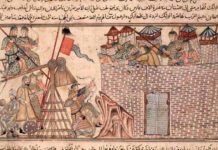The agreements of World War II were challenged in Korea. Start of the Korean War one marker of official start of Cold War Hostility between US & USSR in the 20th Century.
Wartime agreements at Yalta and Potsdam may have confirmed the division of Korea and the creation of the Soviet “buffer zone” of North Korea, however the Allied victory soon led to further conflict. The Korean War is more evidence of the history of warfare in the long 20th Century and proved the start of the Cold War “arms length” hostilities between the United States and Soviet Union.
Historians Sergei Goncharov, John W Lewis, Xue Litai collaborated on the book Uncertain Partners: Stalin, Mao and the Korean War which provides insight, oral history and documentary translations of events leading up to the War in Korea from a range of sources. This document discusses some background to the events leading up to the Korean War as detailed in the book Uncertain Partners.
Some Background to the Korean War
The following is a brief resume of some details of the Korean War:
- War in Korea starts 25 June 1950
- This occurs less than five months after the signing of the Sino-Soviet treaty
- Senior leaders in Moscow and Beijing knew by end of 1949 that Kim II Sung would invade South Korea
- Mao advised Stalin that he did not believe the US would interfere in an “internal matter which the Korean people would decide for themselves”.
The Rise of Kim II Sung of North Korea
The early post-war years saw North Korea as a virtual satellite of Moscow and wholly dependent on the Soviet Union. North Korean leader Kim II Sung had received intensive military training in Russia and gained a deep seated belief in the armed unification of Korea.
In October 1945 Kim II Sung returned to Korea and was chosen as leader by Moscow, with Stalin’s approval
Stalin may have regarded Kim II Sung as a puppet leader but events proved that he in turn was manipulated by the North Korean leader
In 1947 the Soviet-American Commission on Korea concluded that Soviet and American interests were irreconcilable and there would be no unified government for Korea
Kim II Sung claimed to have support in the South, stating that there were powerful revolutionary forces in South Korea and managed to convince Stalin that this was the case
Global US/Soviet hostility mounted and Kim II Sung aided by Soviet Ambassador to the South, Terentii Shytkov managed to form Stalin’s opinions on the area.
Formal Division of Korea 1948
The formation of the Republic of Korea and the Democratic People’s Republic of Korea in August/September 1948 confirmed the formal division of the Korean peninsula at the 38th parallel. Both sides were antagonistic to the other and worked to unite Korea, aided and abetted by their respective foreign patron. For North Korea this entailed the acquisition of the massive military hardware left by the Soviet occupying forces, which was added to the substantial weaponry already siezed from the defeated Japanese armies.
Events Leading up to the Korean War
The following lists some details of the events leading up to the war in Korea from the perspective of Kim II Sung and North Korea:
- North Korea was convinced of its military advantage
- South Korea evinced discontent against the Rhee government
- Constant reports back to Stalin of border clashes and incursions by the South
- In Spring of 1949 Stalin is said to have urged Kim II Sung to strike at South Korea to stem border clashes and promised further arms if necessary
- From early 1949, top Soviet military advisors based in Korea began to push for more aggressive action along and below the 38th Parallel
- Guerilla bands from North Korea began to cross the border and establish bases in the mountains
- Kim II Sung calls for peaceful unification but hopes guerillas will overthrow Seoul regime by end of 1949
- By December 1949 guerilla incursion effectively crushed and Rhee becomes stronger in South Korea.
In conclusion, it became apparent to Kim II Sung by December 1949 that a full scale offensive against the South would be needed if Korea was to be taken wholly under communist rule. Furthermore, Kim’s tactics formed Stalin’s opinions on Korea ensuring he became agreeable to aggressive action. While Soviet fears of encirclement by the capitalist West and finalisation of the Sino-Soviet accord added to raised levels of tension and suspicion within the region.
Source:
- Sergei Goncharov, John W Lewis, Xue Litai, Uncertain Partners – Stalin, Mao & the Korean War








